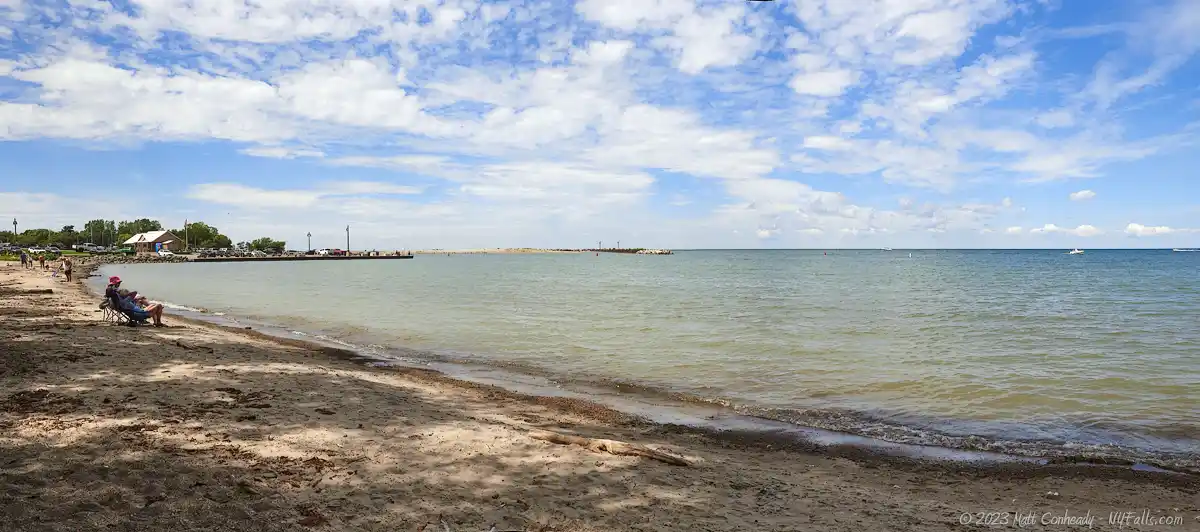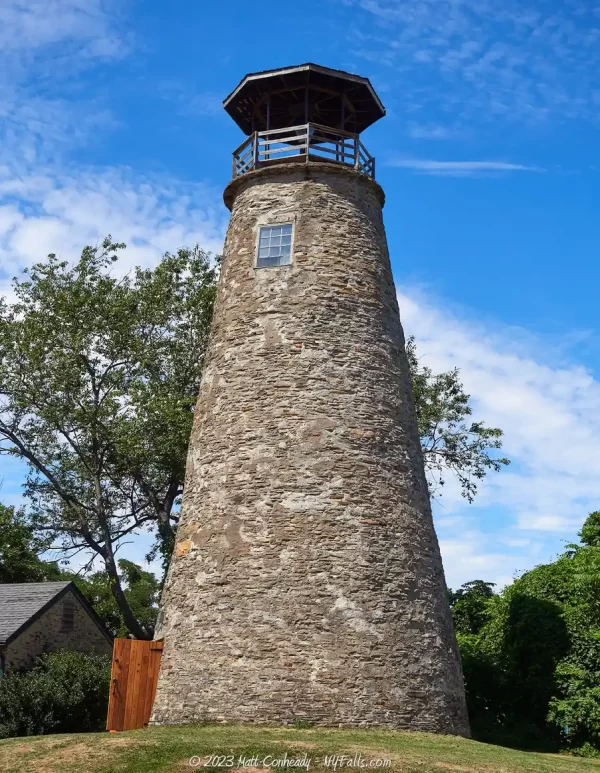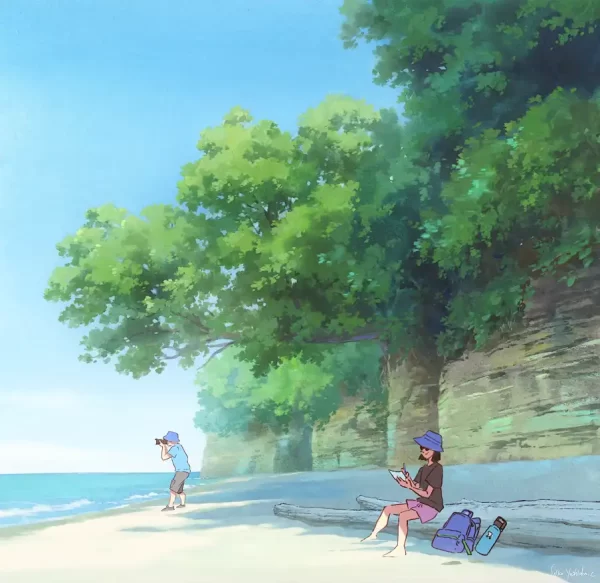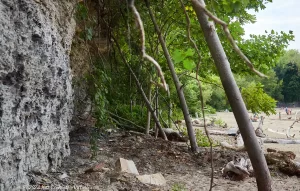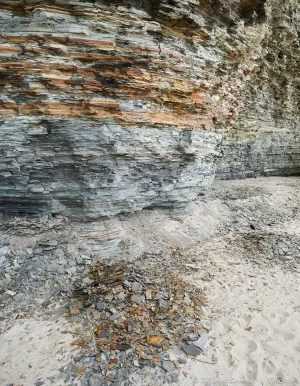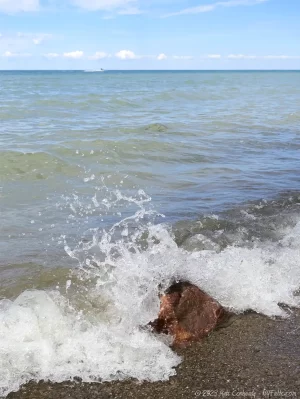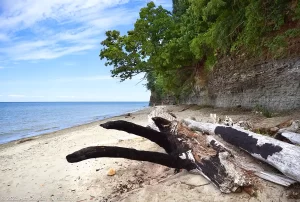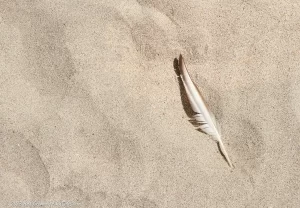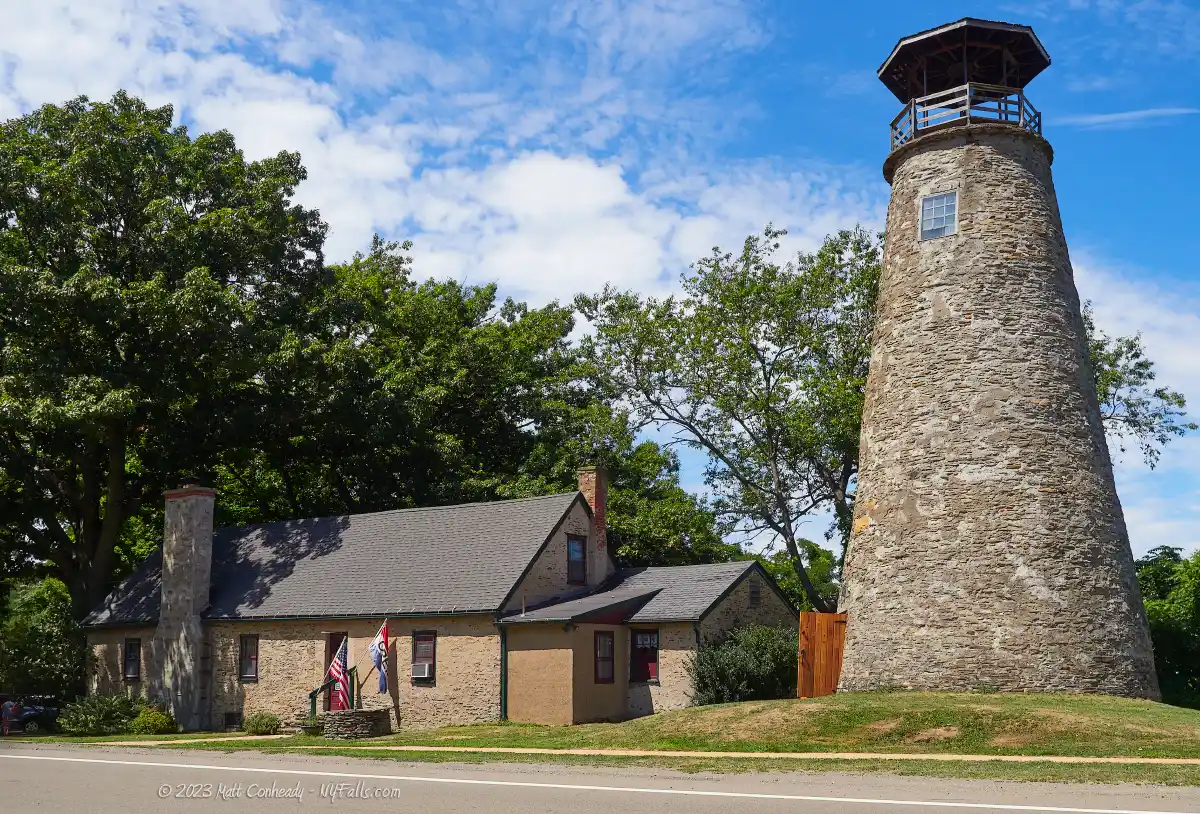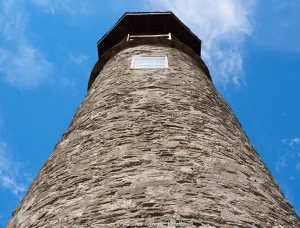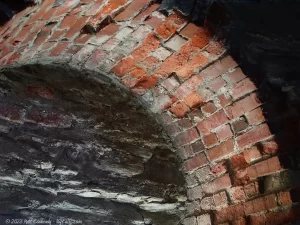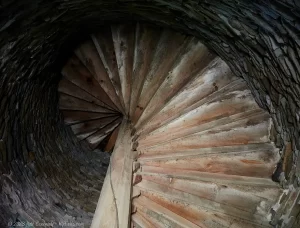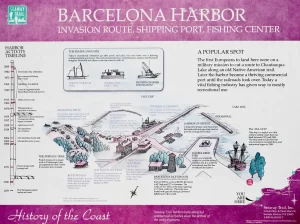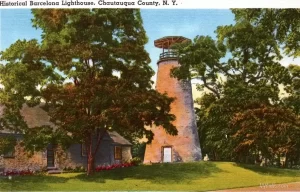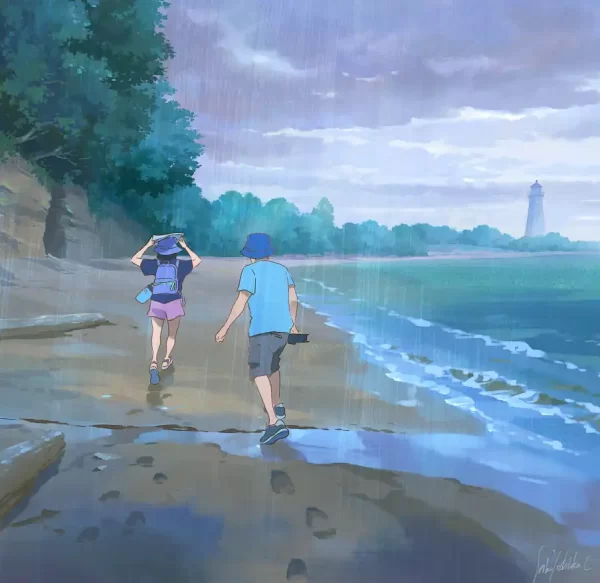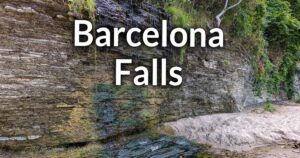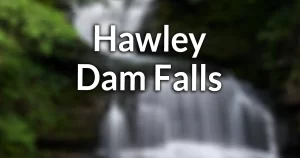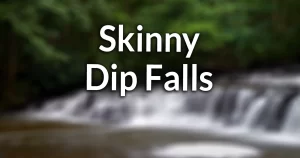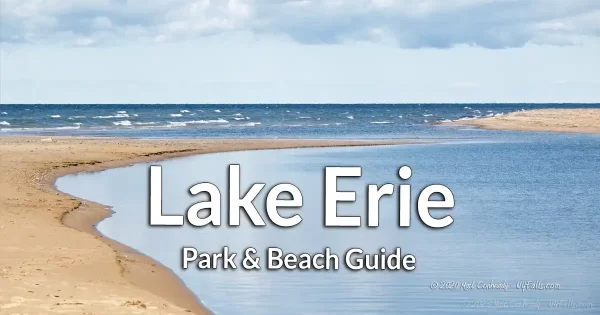Barcelona Harbor Beach & Lighthouse
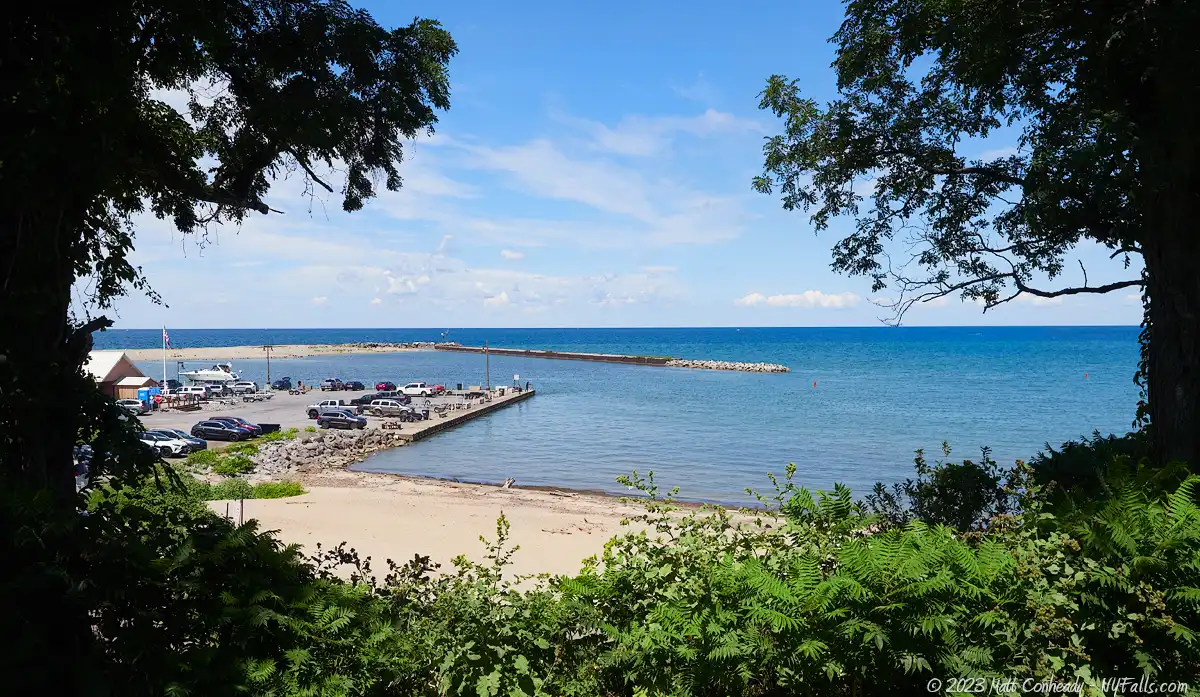
Location: On the east end of Lake Erie; west of Dunkirk; in hamlet of Barcelona; town of Westfield; Chautauqua County; New York.
Maps: Google map; Topographic; Interactive map
GPS Coordinates:
- Barcelona Light: N 42.34109 / W 79.59481
- Parking near Beach: N 42.34178 / W 79.59339
- Beach: N 42.34194 / W 79.59307
- Barcelona Falls: N 42.34172 / W 79.59207
Directions: From east and west:
- Take I-90 to exit 60 for NY-394 toward Westfield/Mayville.
- Turn right (west) onto NY-394 W into Barcelona and follow for 0.3 miles.
- Turn right onto NY-5 and at 0.1 mile the Barcelona Harbor Pier will be on your left. Turn into the entrance.
- Park on the paved pier or head halfway down the hairpin turn right to a gravel parking area next to the beach.
Use Google Directions.
Parking: Right at the entrance to the pier on the east side is a set of spaces for cars. In the middle of the pier is parking for trailers. Beachgoers usually park on the gravel ramp leading down to the beach on the east side. Additional parking can be found along the pier. Obey signs.
If there are no available spots at the pier, the next closest public parking is at a public beach on the other side of the hamlet, about a 3 minute walk. It’s at the intersection of Main and 1st Streets.

Weather
Information / Accessibility / Accommodations
Seasons/Hours:
- The beach is open year-round; Daylight hours.
- The pier is open Daybreak to 8pm, weather permitting.
- The lighthouse grounds are open year round to visitors. The visitors center inside the lightkeeper’s quarters is open from 10 am to 4pm daily, Memorial Day through Columbus Day. the lighthouse tower is currently closed for rehabilitation.
Admission: Free parking and access to the beach and lighthouse. The marina has fees for launching and slips.
Best time to visit: Summer.
Time: A few hours to see the lighthouse and chill on the beach.
Handicap accessibility: Views from the pier. An ADA accessible kayak launch is located on the pier. The lighthouse has a set of 4 steps at the entrance. The beach is down an embankment.
Pets: Not allowed at the lighthouse. Allowed on a leash on the pier and at the beach. Pets are not allowed in the water.
Swimming: Because this beach is not guarded, it’s against state law to swim here. People do it anyway.
Boat launch: Two ramps are located on the west side of the Barcelona Pier that carry a $5 fee. You can hand launch from the beach.
Accommodations: Beach, visitors’ center at the lighthouse, fishing off the pier, boat launch, slips, some picnic tables can be found on the pier. The harbormaster’s office offers fishing licenses. For food, we highly recommend taking the short journey south to Westfield where there are a handful of nice eateries, including one of our favorites, the Parkview.
Description
Barcelona is a small village located on the shores of Lake Erie the town of Westfield in Chautauqua County, NY. The harbor was built in the early 20th century to accommodate the growing fishing industry in the area. An important hub for the commercial fishing industry and transportation hub for the village, the harbor allowed goods to be shipped in and out of the Chautauqua region to all regions in reach of the lake. As industry waned, lake tourism sprouted up and the harbor become a popular spot for recreational boating and fishing, and many residents and tourists would come to the harbor to take in the beautiful views of the lake. While today the harbor is not as popular as it once was, it’s still a fun lake stop just off of I-90 in Western New York if you are passing by.
The Barcelona Lighthouse, located just southwest of the pier on NY-5, is one of the state’s smallest State Parks. Built in 1829, the striking stone tower and dwelling can be seen while driving by, but a quick stop to the visitor’s center inside will yield a small guided museum of interesting facts and artifacts about the lighthouse and the surrounding area. As of 2022, the steps leading up the tower were closed and awaiting rehabilitation. It was listed on the National Register of Historic Places in 1972.
The Barcelona Harbor Pier (Daniel Reed Pier) was constructed in the 1950s to enhance the commercial fishing industry and the pier now serves recreation. When we visited in 2022 some of the pier was under construction, which is great because it was looking a little run down. Still, several people were travelling up and down it for views of the lake. A couple was fishing, and boats were lined up at the launch. A little touch up work will make this a wonderful place to hang out in summer.
Barcelona Harbor Beach is a small sandy beach just east of the pier. Google maps has this marked on the west side of the village, but here we are focusing on this small beach adjacent to the pier, which the town and country seem to agree upon the name for. There’s about 1/4 mile of sandy beach here backed by a short rocky cliff. Along this cliff can be found 3 seasonal waterfalls, the name for all (depending on who you ask) is Barcelona Falls, and they pour off of the cliffs and run down the sand into the lake. When we visited in a mild summer, the falls were just damp and dripping algae-covered cliffs, so if you plan on seeing them flowing, try to visit in spring or after heavy rain. We found the western side of the beach to be quite stinky due to the buildup of algae from the pier. The stench lifted shortly after and the slim sandy beach, littered with sun-bleached driftwood and shaded by the cliffs to the back, was quite enjoyable. There was an abundance of trash. We encountered bottles and some rusty car parts. It could use more maintenance, but the scenery was enough to look beyond that.
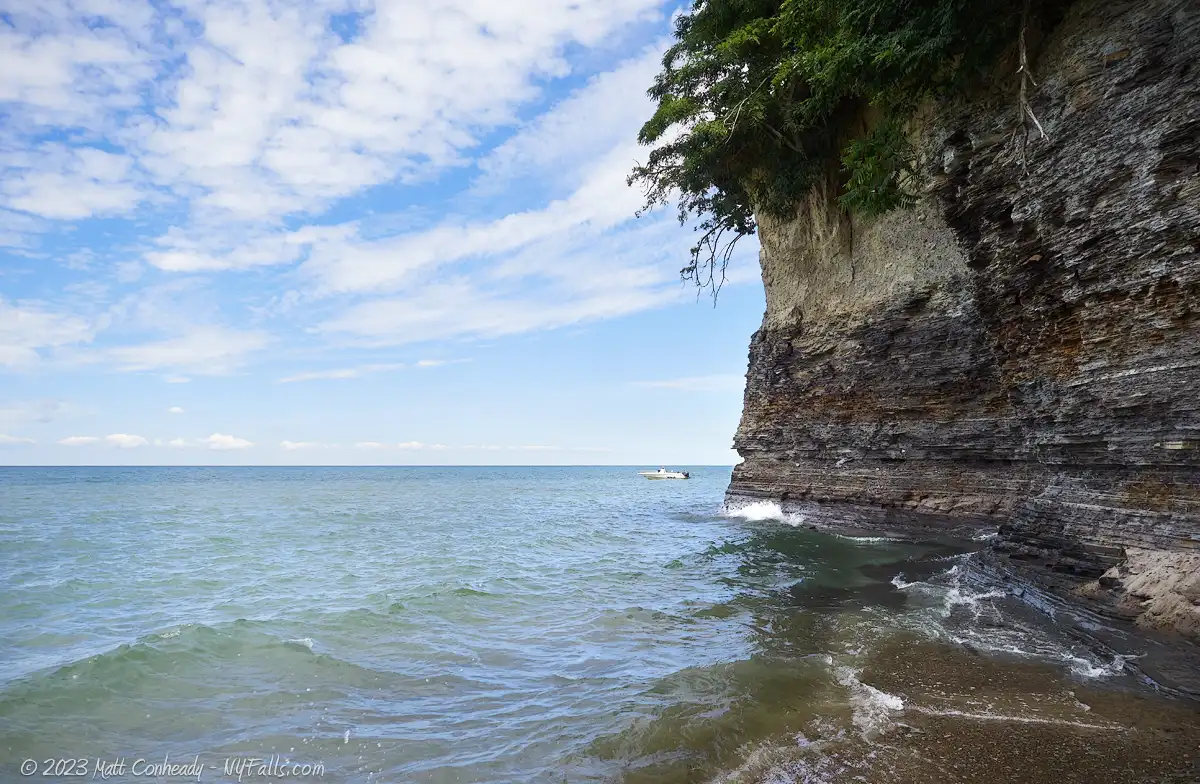
History
Portage Trail
Native Americans used the Portage Trail from Chautauqua Lake to Lake Erie at Barcelona long before white settlers reached the region. It was called “Portage” as it was most commonly used to carry boats across land from one lake to the other. The trail was expanded into a road by the French for a supply route in the 1750s during the French-Indian War (sometimes it’s referred to as French Road) and was used again in wartime by the British briefly during the American Revolutionary War. Currently most of NY-394 runs along this historic route.
Daniel A Reed Memorial Pier
Daniel A Reed was born in Sheridan, Chautauqua County, NY on September 15, 1875. He was a US Representative from the State of New York from 1918 until his death in 1959. For years after WWII he has pushed for funding to develop the harbor to counter the decline in the commercial fishing industry. While he secured funding in 1949 and construction began in 1957, the fishing industry was largely gone by then. The pier opened the year after his passing.
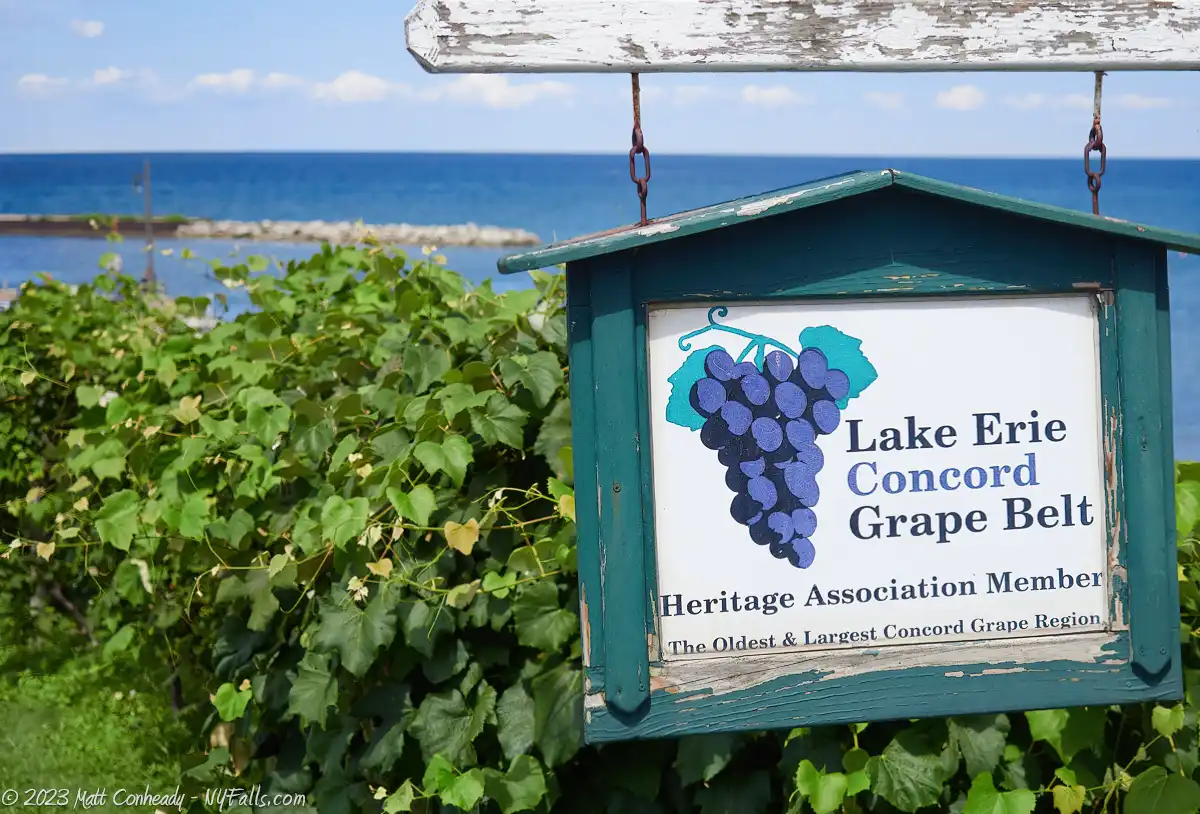
Barcelona and the Harbor
The hamlet of Barcelona was first laid out as the village of Portland, in the town of Portland, by surveyors of the Holland Land Company. The natural harbor was also known as Portland Harbor. The village name changed to Barcelona (after Barcelona, Spain) when the town of Westfield was formed from the towns of Portland and Ripley. The first settlers in this area arrived in 1802 from the state of Pennsylvania (James and John McMahan), who settled southeast in Westfield by Chautauqua Creek, constructing a sawmill.
In 1829, the port was declared an official port of entry by the US, and a lighthouse was installed at the harbor and within months, trade businesses sprung up in the village. The WM. Peacock, a steamboat constructed in Barcelona, began operation in 1829, carrying passengers from Buffalo to Erie, making a stop at the Barcelona Harbor. It exploded en route to Detroit on September 21, 1830, killing at least 12 passengers and severely scalding scores more. The Barcelona Company was formed with the goal of developing the village for commerce to take advantage of the port. They successfully built a hotel and five stores, but their plans to grow even further were thwarted when a small canal opened up the Port of Erie in 1844. This new port opened up Lake Erie shipping traffic to the Ohio River, and through that, the entire Mississippi basin, absorbing most of Barcelona’s shipping business. A massive storm , also in 1844 damaged the harbor severely, crippling operations. The arrival of the Buffalo Erie Railroad to Westfield in 1952, was the nail in the coffin for shipping at the harbor. The US government had started construction on the western breakwater in 1846, but as the shipping industry here dried up, construction was abandoned and the breakwater remained incomplete.
In the late 19th century, manufacturing began to take a foothold in Barcelona. Several factories and mills were built in the area, producing goods such as furniture, textiles, and lumber. The village’s economy was greatly impacted by the growth of these industries, and many residents found employment in the factories and mills. The village was incorporated in 1892 and saw a population growth as a result of the job opportunities.
Th commercial fishing industry grew at the port, carrying well into a 20th century and sustaining the village as manufacturing businesses diminished. The Barcelona Harbor went through a construction phase in the early 20th century to accommodate the growing fishing industry in the area. The harbor was an important hub for the commercial fishing industry, which often took in 140 million pounds of catch in a single year. Further plans to expand and improve the harbor were made in the 1940s, including plans to construct the Daniel Alden Reed Pier. Unfortunately, in the 1950s, due to a hundred years of abuse, fish populations collapsed and the commercial industry tanked. The pier, having already secured funds, was still constructed.
The harbor then turned to serve tourists and recreational fishermen. A few residents also opened businesses catering to tourists, and this did well for a time. In 1960, the US government erected a 693-ft-long east breakwater and a 790-ft-long west breakwater to enhance and protect the harbor for recreational activities. Extensions were added to both in 1984.
Recently, much of the tourism commerce has migrated south to the village of Westfield, with just a few serving Barcelona today, such as the B&Bs across the street from the lighthouse.

Barcelona Harbor Lighthouse
The Barcelona Lighthouse was built in 1829, as part of the federal government’s efforts to improve navigation on Lake Erie. At a cost of $2,700, Judge Thomas Campbell built the 40-ft tall octagonal stone tower and keeper’s dwelling. Native rough-split fieldstone was used in their construction. The light was originally an Argand lamp with a reflector and it had a range of 5 miles. Out of an appropriation of $5,000, construction was under-budget at a total of $3,506.78 when the finishing touches were put on in 1829. On May 27, 1829 Joshua Lane was appointed the first lighthouse keeper at a salary of $350 per year. The light was first powered by oil, but upon discovery of natural gas deposits less than a mile south of the village, it was converted to run continuously on natural gas beginning on January 1, 1831. Hollow wooden pipes were used to carry the gas from the spring, but the whole system was unreliable. Oil remained as a backup. It was the first lighthouse in the country to use natural gas.
The lighthouse was in operation for many decades, and it played an important role in the growth and development of the region. Many ships relied on the light to navigate the lake safely, and it was a vital link in the transportation network of the Great Lakes. Several factors led to the demise of the lighthouse as a navigational beacon. Development of the harbor, including the construction of breakwaters extended the reach of the harbor and expressed the need for navigational beacons further out in the lake. The decline of the shipping industry and the damage from the 1844 storm, further changed the landscape and its importance. The light stopped operations sometime between 1851 and 1852 and closed completely in 1859. It was slated for teardown and the land sold to the highest bidder. Oddly enough, there were no sales and the lighthouse remained closed and unoccupied until 1872 when Lt. Governor George Patterson bought the land for $5 and the buildings for $500. The Patterson family owned and kept up the property for 126 years. For a brief period in 1941 a Dunkirk company opened the dwelling as a refreshment stand. In 1943, the Patterson family did various improvements to the keeper’s dwelling, including expansions, as well as restorations of the tower.
In the early 20th century, with the advent of new technologies, such as electric lights, the Barcelona Lighthouse was decommissioned and replaced by a newer and more powerful electric light located on the breakwall.
In 2008, the New York State Office of Parks, Recreation and Historic Preservation acquired the property and structures. The keeper’s dwelling was modified into a museum and visitors’ center. Today, the lighthouse is open to visitors during the summer months, and it is a popular tourist attraction in the area. Visitors can tour the lighthouse and learn about the history of the lighthouse and the life of the lighthouse keeper. Improvements, including restoring access up the centuries old tower are slowly in the works.
The Barcelona Lighthouse is a great example of the maritime history of the Great Lakes, and it is a reminder of the important role that lighthouses played in the history of the region. It is also a beautiful example of early 19th century architecture, and it offers visitors a glimpse into the past and the daily life of a lighthouse keeper. The lighthouse continues to be an important part of the community and it is a symbol of the history and the heritage of the region.
Hiking / Walking Trails
Difficulty: Easy
Distance: Less than half a mile to walk up and down the pier and then along the beach.
Markings: None.
Description: From any of the parking areas walk up and down the pier. then head west onto the sandy beach. Continue until you can proceed no longer, then head back. Continue west past the pier to the lighthouse.
Map: Check out the interactive map.
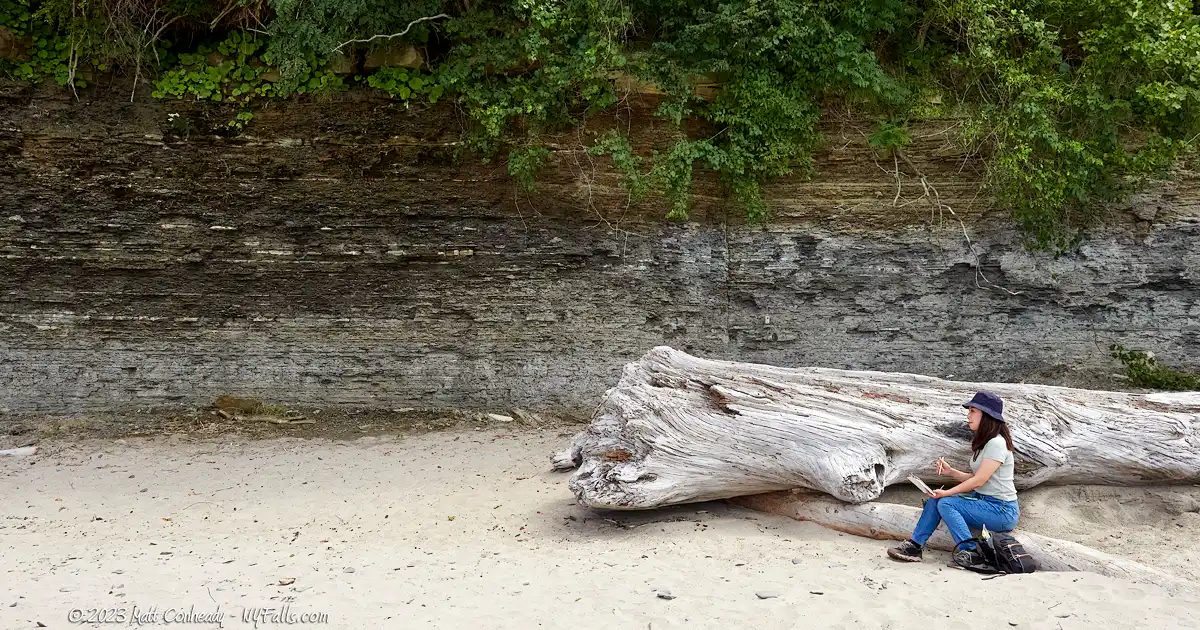
Barcelona Harbor Lighthouse & Beach Interactive Map
Fishing
Fish from the north or east ends of the Daniel A. Reed Memorial Pier.
Interesting Stuff
Barcelona Falls
Waterfalls on seasonal tributaries fall over a 10-15 ft cliff right onto the beach at Barcelona Harbor. These seasonal waterfalls typically dry up by summer, but if it happens to be raining for a few days prior to your visit, they may be flowing. There are two very small ones that dry up first and then one larger one that at last has a trickle through June. They are here, right at this beach. Just hike east and watch the cliff.
The Portage Trail
The Portage Trail is a historical trail located in Westfield, New York. It is a part of the larger trail system that was used by Native Americans and early European settlers for transportation and trade. The trail runs along the eastern shore of Lake Erie and connects the village of Westfield to the village of Barcelona.
The Portage Trail was used for centuries by Native Americans as a way to portage or carry their canoes from one body of water to another. The trail connected various waterways, including Lake Erie and the Chautauqua Creek, allowing for trade and transportation between different tribes and regions. Early European settlers also used the trail as a way to access the interior of the region and as a trade route.
During the late 18th and early 19th century, the Portage Trail became an important transportation route for the burgeoning timber industry in the region. Logs were floated down the Chautauqua Creek to the trail, where they were then transported by oxen teams to sawmills on the lake. The trail also played an important role in the development of the region’s agriculture and fishing industries.
Today, the Portage Trail is a popular spot for hiking, biking, and bird watching. The trail is well-maintained, and it offers visitors the opportunity to explore the natural beauty of the region and learn about its history. The trail also offers access to the historic Barcelona Lighthouse and the Barcelona Harbor, making it a popular destination for tourists and history buffs. N Portage St, just west of the lighthouse is the northern terminus of the trail.
In recent years, there have been efforts to preserve and promote the Portage Trail as a historical and recreational resource. The trail is now a part of the state parks system and it is protected by the state. The trail is also part of the larger Chautauqua-Allegheny Region Trail System. The trail offers visitors the chance to explore the natural beauty of the region and learn about the history of the area through interpretive signs and brochures. Here is a map of the current trail system.
Marmaduke
A few miles west of Barcelona on NY-5 in Brockton, NY is a statue of this well-known Great Dane from comic strips and his creator, cartoonist Brad Anderson (May 14, 1924 – August 30, 2015). Anderson was born in Brockton. Anderson’s art studio was re-created for the National Comedy Center in Jamestown, New York.
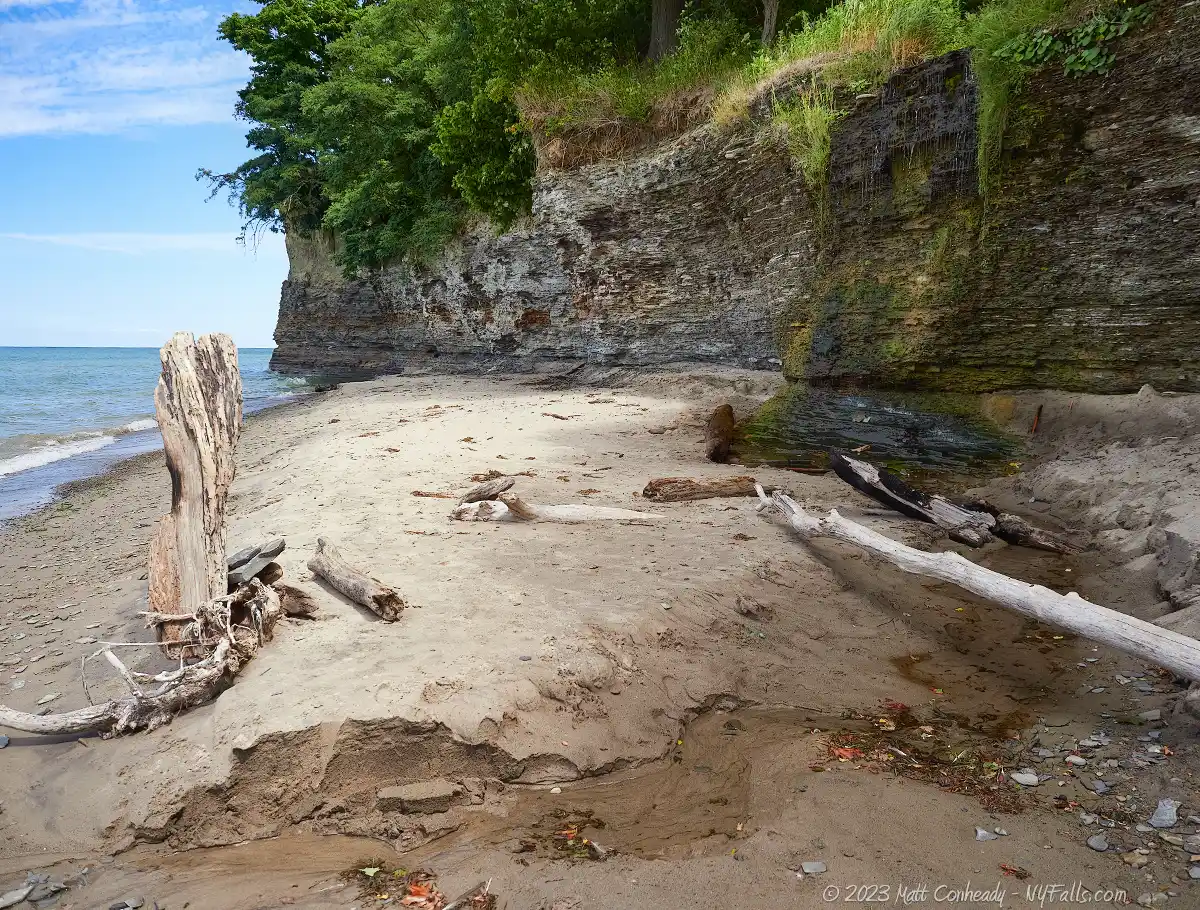
Photography Tips
Weather
- Lakes photograph best on partly cloudy days with clouds on the horizon. The blueness of the lake depends on how few clouds and the angle of the sun.
- On the other hand, the waterfalls along the cliffs only flow after/during rain and photograph best under overcast skies.
Cliffs and Driftwood
- The sheer cliffs that boarder the beach make for a great subset and the sun-bleached driftwood scattered are good foreground objects to include in your lake shots.
More tips
- See the Articles and Message Board sections for more photography tips.
Nearby Waterfalls
More Lake Erie Parks & Beaches
Find a new summer hangout spot or place to swim in our comprehensive guide to Lake Erie Parks and Beaches in New York State.
Who to Contact
Barcelona Lighthouse State Park
8234 E Lake Rd (Route 5)
Westfield, NY 14787
(716) 326-2360
[email protected]
Barcelona Pier Harbor Master
(716) 326-6633
